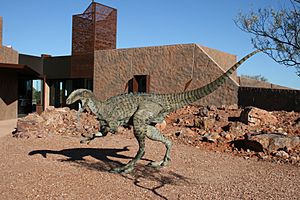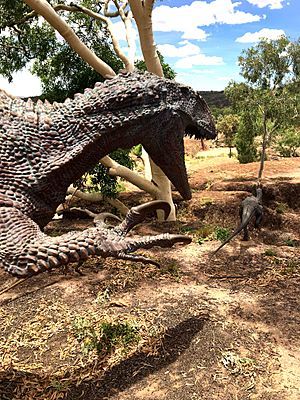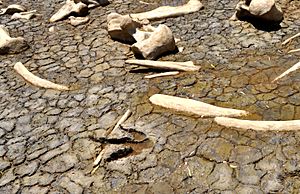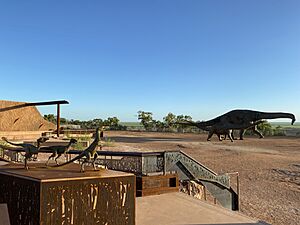Australian Age of Dinosaurs facts for kids

AAOD Reception Centre with bronze Australovenator wintonensis (Banjo)
|
|
| Lua error in Module:Location_map at line 420: attempt to index field 'wikibase' (a nil value). | |
| Established | 2002 |
|---|---|
| Location | Lot 1, Dinosaur Drive, The Jump-Up Dark-Sky Sanctuary, Winton, Queensland |
| Type | Museum of Natural History |
| Key holdings | Australovenator wintonensis "Banjo"; Diamantinasaurus matildae "Matilda" and "Alex"; Wintonotitan wattsi "Clancy"; Savannasaurus elliotorum "Wade"; Ferrodraco lentoni "Butch"; the Snake Creek tracksite; Confractosuchus sauroktonos "Chookie" |
| Collections | Australian natural history |
| Visitors | 59,148 (2021) |
The Australian Age of Dinosaurs Ltd. (AAOD) is a special place in Winton, Queensland, Australia. It was started in 2002 by David and Judy Elliott. This organization runs the Australian Age of Dinosaurs Museum of Natural History.
The museum also organizes yearly dinosaur digs in the Winton Formation area. It has Australia's busiest dinosaur fossil preparation lab, which works all year round. Since 2005, the AAOD Museum has gathered the biggest collection of Australian dinosaur fossils in the world.
It holds important original fossil finds, like Diamantinasaurus matildae (nicknamed "Matilda") and Savannasaurus elliottorum ("Wade"). It also has Australovenator wintonensis ("Banjo"), which is Australia's most complete skeleton of a meat-eating dinosaur. Other key fossils include Ferrodraco lentoni, the first flying reptile (pterosaur) found in the Winton Formation, and Confractosuchus sauroktonos.
The museum is open to visitors every day from April to October. From November to March, it is open six days a week, closed on Sundays. In 2019, the museum's location became Australia's first International Dark-Sky Sanctuary. This means it's a great place to see the stars because there's very little light pollution.
Contents
Where to Find the Museum
The AAOD Museum sits on top of a big flat-topped hill called 'The Jump-Up'. This spot is about 24 kilometers (15 miles) south-east of Winton. It is also about 600 kilometers (370 miles) south-west of Townsville.
If you are coming from Longreach, you drive north-west on the Landsborough highway for about 164 kilometers (102 miles). Then, you turn left onto Dinosaur Drive. From there, it's another 11 kilometers (7 miles) on a sealed road to reach the museum. You can tow caravans to the top of the Jump-Up. There is also a special area at the bottom of the hill to unhitch caravans if your car is small.
Museum History and Discoveries
In 1999, David Elliott found a fossilized bone while looking after sheep on his farm near Winton. This bone turned out to be from a giant sauropod dinosaur that lived 95 million years ago. It was the largest dinosaur bone found in Australia at that time.
After finding more fossils with the Queensland Museum, David and Judy Elliott decided to start a dinosaur museum in Winton. In October 2002, they officially began 'Australian Age of Dinosaurs Incorporated'. This was a non-profit group. Its goal was to keep finding, preparing, and saving dinosaur fossils from the Winton Formation.
With help from many volunteers, the group started building a major tourist attraction: a dinosaur museum. This would help protect the discoveries and share them with the public forever.
Amazing Dinosaur Finds
In March 2005, David Elliott found a new dinosaur site on his farm. A dig there in September uncovered one of Australia's most complete sauropod skeletons. They recovered 17 pallets of fossil bones! This dinosaur was named "Wade" to honor Australian paleontologist Dr. Mary Wade, who passed away during the dig.
Later in 2005, another discovery on Elderslie Station led to finding two dinosaur skeletons together. One was a sauropod, nicknamed "Matilda." The other was a meat-eating theropod, nicknamed "Banjo." Both were named after Andrew Barton "Banjo" Paterson and his famous poem "Waltzing Matilda."
The Prep Shed and New Museum Site
In mid-2006, David and Judy Elliott opened a temporary fossil preparation place in their shed. It was called the "Prep Shed." Here, staff and volunteers carefully cleaned and prepared the fossils. They started with "Wade" and then worked on "Banjo" and "Matilda" as more bones were found. This work went on for almost three years with over 100 volunteers helping.
In September 2006, Peter and Carol Britton donated 1,400 hectares (about 3,460 acres) of their land, Mt. Landsborough Station, to AAOD. This land, part of the "Jump-Up" country, was chosen for the future museum. Over the next three years, money was raised to fence the new site. The Winton Shire Council built a new road to the top of the Jump-Up. The Queensland Government gave $500,000 for a fossil preparation building, staff homes, and water and power.
The old Prep Shed closed, and all fossils and equipment moved to the Jump-Up in early 2009. The new buildings opened to the public in July 2009. Queensland Premier Anna Bligh officially opened them as part of Queensland's 150th birthday celebrations.
In June 2008, the organization changed its structure to become Australian Age of Dinosaurs Ltd. (AAODL). This new company created a group called the Australian Age of Dinosaurs Society for members and supporters. The museum's special supporter is Dame Quentin Bryce.
On January 25, 2024, David Elliott was named Australia’s Local Hero by the Prime Minister, The Hon Anthony Albanese MP. He received this award for helping to bring back "palaeotourism" (tourism focused on fossils and ancient life) in Australia.
Museum Buildings and Exhibits
The AAOD Museum is being built in three stages. Each stage is in a different part of the Jump-Up. Stage 1, which includes a temporary fossil preparation building and homes for staff and volunteers, is finished. Stage 2, which has the museum's reception center and a public car park, is also complete. Stage 3, the future main museum building, has finished its early planning. Some outdoor galleries have started construction. The main museum building still needs funding to be built.
Fossil Preparation Laboratory
The laboratory is about 500 meters (1,640 feet) from the reception center. Here, experts clean, save, and fix dinosaur fossils. This work prepares the fossils for scientific study and for display in exhibits. The building has areas for storing unprepared and prepared fossils. It also has a large area where staff and volunteers work to remove rock from the bones and make them strong. There are also rooms for staff, an office, a waiting room for visitors, and storage for equipment.
Dinosaur fossils are often found stuck in hard rock. It takes a lot of time and care to chip the rock away. In the lab, they use special tools to remove rock from the bones. They also fix, restore, and strengthen the fossils. Sometimes, they sort tiny pieces of rock to find microfossils. They even put bone fragments together like a giant jigsaw puzzle!
You can help with this work by becoming an "honorary technician." This involves a 10-day fossil preparation course at the museum called 'Prep-A-Dino'.
Dinosaur Canyon Outpost and Outdoor Galleries
Dinosaur Canyon Outpost and Outdoor Galleries opened in April 2017. It was built with money from the government, private sponsors, and the museum's own funds. This new area has an Outpost building on a cliff overlooking Dinosaur Canyon. It also has a 300-meter (984-foot) elevated concrete pathway. This pathway winds through huge boulders and thick plants in the gorge below, like a treetop walk.
Along the pathway, there are five outdoor galleries. These exhibits show what life was like during the Cretaceous Period. They include: Dinosaur Stampede, Pterodactylus Family, Kunbarrasaurus ieversi, Death in the Billabong, and Valley of the Cycads.
The March of the Titanosaurs Exhibition
The March of the Titanosaurs exhibition opened in May 2021. This building was made to hold a 55-meter (180-foot) long fossil trackway. This trackway was moved to The Jump-Up between 2018 and 2021. It shows the footprints of sauropods, theropods, ornithopods, crocodiles, turtles, and lungfish.
Dinosaur Fossils and Their Age
Dating Fossils
Most of the dinosaur fossils found by the AAOD Museum are from the early Late Cretaceous period. They are about 98 to 95 million years old. Scientists figure this out by using a method called radiometric dating. They look at tiny grains called zircons, which are found in the sandstones of the Winton Formation. By measuring special elements inside these zircon grains from the "Matilda site," they confirmed the fossils are at least 95 million years old.
The Winton Formation
The Winton Formation is a layer of rock that formed from ancient river floodplains. These rivers flowed north into the Eromanga Sea during the late Albian to Cenomanian stages of the Cretaceous period. This rock layer can be up to 1.2 kilometers (0.75 miles) thick in southwest Queensland.
The Winton Formation sits on top of older marine (sea) deposits called the Mackunda Formation. The Mackunda Formation shows the last time an inland sea covered the Winton area, about 100-98 million years ago. The Winton Formation has given us more large dinosaur remains than all other parts of Australia combined. This makes it the country's most important dinosaur fossil area.
The Great Australian Basin
The Great Australian Basin covers almost one-fifth of Australia. It includes three smaller basins in Queensland. Over 30 million years, this huge basin was covered by inland seas five different times. The Winton Formation is in the Eromanga Basin and is the youngest rock layer there. This land-based deposit marked the end of 30 million years when the area was covered by sea. It became a place of lush forests, floodplains, and many dinosaurs.
Over the last 98 million years, the Eromanga Basin has changed a lot due to weather, erosion, and land rising. This process has brought the fossil-rich rocks to the surface, especially north of Winton. These rocks continue to reveal fossils of Australia's Cretaceous dinosaurs throughout the Winton Formation.
The Jump-Up Plateau
The Jump-Up is a large, flat-topped plateau. It is about 270 meters (886 feet) above sea level and stands 75 meters (246 feet) higher than the land around it. It is part of a larger landform called the Vindex Range. Like much of the Winton area, the Jump-Up is made of rocks from the Winton Formation, which are about 95-98 million years old.
The very top of the Jump-Up is solid rock, up to 12 meters (39 feet) thick. This hard rock has stopped erosion from wearing it away, while the land around it was eroded. The top of the Jump-Up shows what the land looked like before this erosion started, which was about 25-30 million years ago.
The Jump-Up is home to many animals, including lizards, echidnas, and over 100 types of birds. It also has unique plants, like rainforest fig trees, that have survived in moist, sheltered gorges. These plants are leftovers from a time when inland Australia had a much wetter climate. In 2019, The Jump-Up was named Australia's first International Dark-Sky Sanctuary. This means it has very dark, starry nights because it's in a remote area with little light pollution.
How You Can Get Involved
Prep-A-Dino Experience
The Australian Age of Dinosaurs has a program where the public can help prepare fossils. It's called Prep-A-Dino. Cleaning a dinosaur bone is a long job. It means carefully chipping away layers of stone to show the bone inside. The museum offers training and a tour before you start working on a dinosaur bone.
The museum also offers places to stay at Maloney Lodge as part of the Prep-A-Dino package. The lodge has five furnished rooms, a shared kitchen, and a fully equipped bathroom/laundry. Maloney Lodge was finished in 2010. It gives people working in the lab a chance to live at a real dinosaur museum. After completing 10 days of training, you can become an "Honorary Technician" with the Australian Age of Dinosaurs. There is a daily charge for the first 10 days of training. After that, Honorary Technicians only pay for a yearly one-day refresher course.
Dig-A-Dinosaur Experience
Since 2004, the museum has held dinosaur digs that people can join. These digs usually happen in late May and early June. There is a fee to take part, which helps cover the costs of the dig and preparing the fossils found. The digs take place in the grassy areas of the Winton district. They have found many dinosaur fossils, and some have become very important original specimens. On the Elliott's farm alone, 15 dinosaur sites have been found across their 18,000-hectare (44,500-acre) property.
Dinosaur Researchers
The AAOD fossil collection has attracted a lot of interest from palaeontologists (scientists who study fossils) from Australia and other countries. Here are some of the researchers who have worked closely with the museum's collection:
Dr. Alex Cook
Alex Cook used to be a curator at the Queensland Museum. He is known for his work on ancient sea creatures and fossils from the Great Artesian Basin. Since 2004, Dr. Cook has been an Honorary Curator for the AAOD Museum Collection. He helps the museum get and care for fossils that show Australia's ancient life. In 2018, the museum published his book, Geology of Outback Queensland.
Dr. Scott Hocknull
Scott Hocknull is a Senior Curator at the Queensland Museum. In 2009, he was the lead author on a paper that named three new Australian dinosaur species from the Winton Formation. These were Diamantinasaurus matildae, Australovenator wintonensis, and Wintonotitan wattsi. Dr. Hocknull is also leading important research into the Dinosaur Stampede National Monument at Lark Quarry near Winton.
Dr. Benjamin Kear
Benjamin Kear is a professor at Uppsala University in Sweden. He is studying marine (sea) fossils in the AAOD Collection. These fossils, including ancient marine reptiles, turtles, and fish, were found near Winton Formation dinosaur bones. Dr. Kear's research will help identify these creatures and understand the variety of marine life in the Eromanga Basin.
Dr. Ada Klinkhamer
In August 2017, Ada Klinkhamer finished her PhD research on the muscles and movement of sauropods. She focused on Diamantinasaurus matildae from the Australian Age of Dinosaurs Museum. She has published two papers from her research, both about Diamantinasaurus matildae.
Dr. Stephen McLoughlin
Stephen McLoughlin is a palaeobotanist (a scientist who studies ancient plants) from the Swedish Museum of Natural History. He has studied fossil plants from the Winton Formation since the mid-1990s. Recently, he has looked at plant fossils from Belmont Station that are in the AAOD Museum collection. The Winton Formation plant fossils are very important because they are the youngest major group of plant fossils from the Cretaceous period in Australia. This plant collection shows the change from cone-bearing plants to flowering plants in Australia.
Adele Pentland
Adele Pentland is a student working on her PhD and a researcher at the AAOD Museum. She is studying Australian pterosaurs (flying reptiles). In October 2019, she scientifically described Australia's most complete pterosaur fossil as a new species, Ferrodraco lentoni.
Dr. Stephen Poropat
Stephen Poropat is a researcher in palaeontology at Swinburne University of Technology. In 2015, he re-examined Diamantinasaurus matildae and Wintonotitan wattsi. In 2016, he scientifically described one of Australia's most complete sauropod fossils as a new species, Savannasaurus elliottorum. Also in 2016, Dr. Poropat described the first sauropod skull ever found in Australia and linked it to Diamantinasaurus matildae. This skull is now on display at the AAOD Museum. He is also researching other Cretaceous sauropod fossils from Queensland.
Travis Tischler
Travis Tischler is an Australian palaeo-artist. He has worked closely with the AAOD Museum since 2006. Since 2009, he has been in charge of the museum's digital dinosaur reconstruction program. He uses computer modeling to create very detailed and accurate models of dinosaurs. By using CAT scans, MRI scans, and photogrammetry, Travis can digitally recreate and restore dinosaur fossils into full skeletons. He studies how they moved and where their muscles attached to create accurate models of dinosaur bodies.
Dr. Paul Upchurch and Dr. Philip Mannion
Paul Upchurch is a Reader in Palaeobiology at University College London. Philip Mannion is a Junior Research Fellow at Imperial College London. Both have visited the AAOD Collection and are working with Dr. Poropat and Dr. Hocknull. Their project aims to thoroughly review Australia's Cretaceous sauropod dinosaurs and understand how they are related to sauropods around the world.
Dr. Matt White
Matt White completed his PhD on how Australovenator wintonensis was built and how it moved. He has written several papers about new bones of Australovenator that have been found since its first description. His research includes studying how the skeleton moved to rebuild the muscles and tendons of Australovenator's arms and legs. Dr. White has also worked with radiographer Sarah Wooldridge to CT scan all the Australovenator fossils and other important fossils from the AAOD Museum. These scans have been turned into 3D images for publications and dinosaur reconstructions.
Future Plans for the Museum
The AAOD Museum's third and final stage is to build a large, modern natural history museum. This new museum will show the story of the Australian continent over the past 4.5 billion years. It will also highlight Australia's unique dinosaur history. The new museum building, which will include education facilities, has completed its initial planning and design.
The AAOD Museum of Natural History will be located 2 kilometers (1.2 miles) from the current Reception Centre. It will be positioned to overlook the plains below the Jump-Up. The plans for the building include a floor space of 6,000 square meters (64,583 square feet). Of this, 1,800 square meters (19,375 square feet) will be for exhibitions. The rest of the space will be for public areas, a gift shop, a café, management offices, a collection room, a lab, classrooms, and audio-visual facilities.
Other exhibitions being planned for the AAOD Museum include a series of outdoor galleries. These will be placed throughout the gorge of the Jump-Up. These galleries will feature life-size bronze sculptures of Australia's dinosaurs and their ancient environment. Construction has already started on the first of these outdoor galleries.




